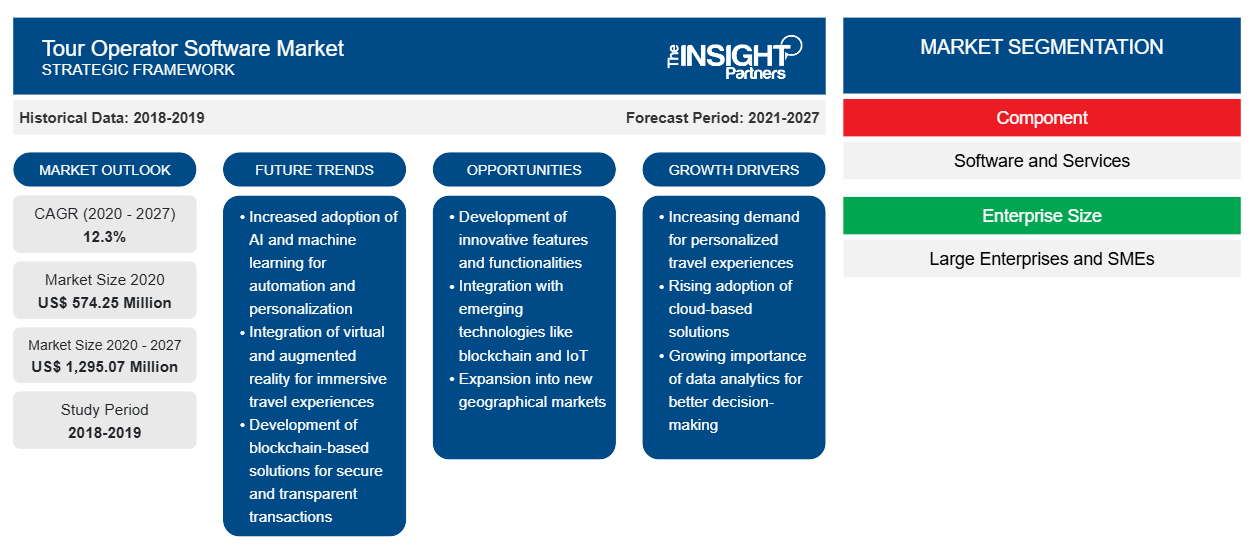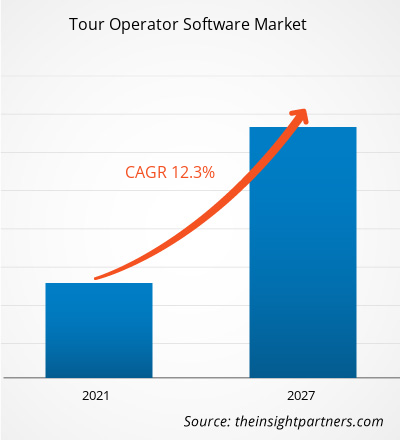The tour operator software market expected to grow from US$ 574.25 million in 2020 to US$ 1295.07 million by 2027; it is estimated to grow at a CAGR of 12.3% from 2020 to 2027.
Mounting tourism industry globally with positive economic outlook is attributing to the growth of the market. The growth of the tourism sector is influenced by factors such as GDP growth, size of the economy, travel infrastructure development, industry mix, population, and regulatory policies. These factors vary from one country to another and affect the travel investment in that particular country. The tourism industry has spurred stupendously over the years and is at a constant rise. The demand for tourism among every class of society has led to the emergence of various types of tourism, such as roadways tourism, waterways tourism, and aerial tourism, among which roadways tourism has dominated the industry for a long period. Increasing disposable income among the masses in developed as well as developing countries has resulted in rising adoption of tour operators to book their tour by opting fascinating offers. Further, the GDP growth in developing countries such as China and India is expected to offer ample opportunities for the market growth in the coming years. With positive global economic outlook, investments in travel infrastructure, growth in SMEs, huge cross border trade volumes, and stabilizing political conditions, the spending on tourism is expected to increase over the next few years around the globe. With increasing globalization and cross border trade, the spending on tourism is also rising. These factors have positively impacted the growth of the tour operator software market.
Customize This Report To Suit Your Requirement
You will get customization on any report - free of charge - including parts of this report, or country-level analysis, Excel Data pack, as well as avail great offers and discounts for start-ups & universities
Tour Operator Software Market: Strategic Insights

-
Get Top Key Market Trends of this report.This FREE sample will include data analysis, ranging from market trends to estimates and forecasts.
Impact of COVID-19 Pandemic on Tour Operator Software Market
The emergence and rapid spread of coronavirus (COVID-19) has paralyzed numerous countries including developed as well as developing. The continuous surge in count of infected patients is threatening several industries across the globe. As of December 2020, United States, India, Brazil, Russia, and France, are some of the worst affected countries in terms confirmed cases and reported deaths. The coronavirus outbreak has been affecting economies and industries in various countries due to lockdowns, travel bans, and business shutdowns. Since majority of the countries are exercising lockdowns, which resulted in the negative impact on the travel and tourism sector. The temporary restrictions on the domestic and international travel by the government of different regions, is also showcasing negative trend in the tourism sector. The continuity of the COVID-19 spread, would be severely dangerous for tour operator software market players.
Market Insights-Tour Operator Software Market
Increasing Adoption of AI across Tourism Sector
The increasing integration of artificial intelligence (AI) for the enhancement in the overall process of booking attractive tour package through operators, which is boosting the adoption of tour operator software. The adoption of AI and robotics in the tourism industry is boosting the customer experience and services offered by the tour operator. With the introduction of artificial travel intelligence, the travel arrangements for the passenger is furthered enhanced to meet their expectations. It also offers superior travel services, which are customized, automated, and insightful. The integration of AI permits the tour operators to study the interests and behaviors of the travelers and offer enhanced experience. The AI in the travel and tourism industry focuses majorly on the customer engagement and service, to further boost the travel experience of the travelers. The emerging AI technologies, such as Chatbots, language translators, and virtual reality in the tourism sectors, are positively impacting the travel, tourism, and hospitality industry. Thus, the rising integration of AI is further boosting the tourism sector across the world.
Component -Based Insights
Based on component, the tour operator software market is segmented into software, services. The software segment held the largest market share in 2019.
Players operating in the tour operator software market are mainly focused on the development of advanced and efficient products.
- In 2020, GP Solutions GmbH and ComBtas had established a strategic partnership. This alliance is intended for customers present in the Israeli market. With this collaboration, ComBtas would promote GP Solutions’ turnkey products including GP travel enterprise and GP travel hub.
- In 2020, Travefy, Inc. had launched a website builder for travel advisors. The website builder enables the advisors to create websites or a marketing landing page. The website builder uses a drag and drop interface, and advisors can choose a theme, customize the content, and custom URLs can be used. Further, the tool is included with the subscription plan.
The regional trends and factors influencing the Tour Operator Software Market throughout the forecast period have been thoroughly explained by the analysts at The Insight Partners. This section also discusses Tour Operator Software Market segments and geography across North America, Europe, Asia Pacific, Middle East and Africa, and South and Central America.
Tour Operator Software Market Report Scope
| Report Attribute | Details |
|---|---|
| Market size in 2020 | US$ 574.25 Million |
| Market Size by 2027 | US$ 1,295.07 Million |
| Global CAGR (2020 - 2027) | 12.3% |
| Historical Data | 2018-2019 |
| Forecast period | 2021-2027 |
| Segments Covered |
By Component
|
| Regions and Countries Covered |
North America
|
| Market leaders and key company profiles |
|
Tour Operator Software Market Players Density: Understanding Its Impact on Business Dynamics
The Tour Operator Software Market is growing rapidly, driven by increasing end-user demand due to factors such as evolving consumer preferences, technological advancements, and greater awareness of the product's benefits. As demand rises, businesses are expanding their offerings, innovating to meet consumer needs, and capitalizing on emerging trends, which further fuels market growth.

- Get the Tour Operator Software Market top key players overview
The tour operator software market has been segmented as follows:
Global Tour Operator Software Market – By Component
- Software
- Services
Global Tour Operator Software Market – By Enterprise Size
- Large Enterprises
- SMEs
Global Tour Operator Software Market – By Subscription Type
- One Time Subscription
- Monthly Subscription
- Annual Subscription
Global Tour Operator Software Market – by Geography
-
North America
- US
- Canada
- Mexico
-
Europe
- France
- Germany
- Italy
- Russia
- U.K
- Rest of Europe
-
Asia Pacific (APAC)
- Japan
- China
- Australia
- India
- South Korea
- Rest of APAC
-
Middle East and Africa (MEA)
- Saudi Arabia
- UAE
- South Africa
- Rest of MEA
-
South America (SAM)
- Brazil
- Argentina
- Rest of SAM
Tour Operator Software Market – Company Profiles
- Checkfront Inc
- GP Solutions GmbH
- Rezdy
- Tourplan
- Travefy, Inc.
- TraveloPro
- Trawex Technologies Pvt Ltd.
- TrekkSoft (TrekkSoft Group)
- TRYTN, Inc.
- Xola, Inc.
Frequently Asked Questions
What are reasons behind tour operator software market growth?
Which enterprise size is expected to dominate the tour operator software market in the forecast period?
What are market opportunities for tour operator software?
- Historical Analysis (2 Years), Base Year, Forecast (7 Years) with CAGR
- PEST and SWOT Analysis
- Market Size Value / Volume - Global, Regional, Country
- Industry and Competitive Landscape
- Excel Dataset
Recent Reports
Related Reports
Testimonials
Reason to Buy
- Informed Decision-Making
- Understanding Market Dynamics
- Competitive Analysis
- Identifying Emerging Markets
- Customer Insights
- Market Forecasts
- Risk Mitigation
- Boosting Operational Efficiency
- Strategic Planning
- Investment Justification
- Tracking Industry Innovations
- Aligning with Regulatory Trends





















 Get Free Sample For
Get Free Sample For